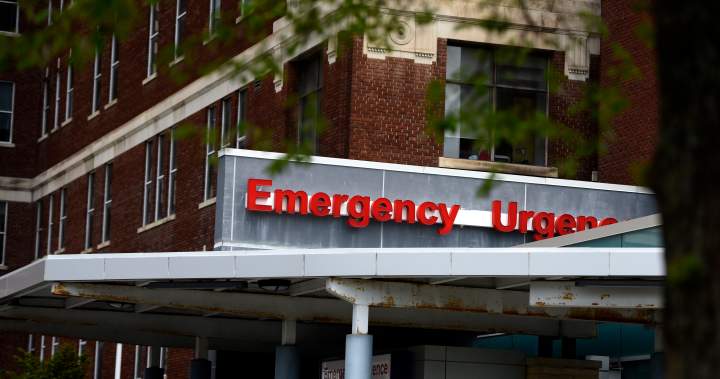The number of emergency room closures in Ontario is dropping, according to new data from the Ford government, as critics demand more transparency around how nursing and physician shortages are impacting the north of the province.
Since a flare-up in emergency room closures in July 2022, Ontario Health has required hospitals across the province to notify it if they are forced to shutter any major department to the public.
The policy was instituted as criticism mounted about the closures, which, according to the auditor general, had been “very rare” before 2020 and ballooned in the summer of 2022.
Now, new data shared with Global News by the Ministry of Health shows the number of closures at hospitals appears to be dropping — although more than 50 instances were recorded last year.
The numbers cover July to December 2022 and the entirety of both 2023 and 2024. They reveal the most reported instances of shut down departments took place in 2023, but hospitals were closed for more hours the year before.
Some of the 2022 issues were significant in length. The Chesley hospital emergency room, for example, shut its doors from October until December, while Perth And Smiths Falls District Hospital’s Perth site was closed for more than 500 hours in July.
The Ottawa Hospital had a closure on its general campus for more than 100 hours in October 2023, while the Hawkesbury and District General Hospital was shut for almost 90 hours over the New Year due to a nursing shortage.
The latest figures covering 2024 saw a substantial drop in the total number of closures without eradicating them. Rainy River Health Centre, for example, was shut for 87 hours in June due to a physician shortage.
In total, according the the government, the figures were:
Get weekly health news
Receive the latest medical news and health information delivered to you every Sunday.
- 2022: 146 closures, 4,233 hours
- 2023: 184 closures, 2,977 hours
- 2024: 53 closures, 774 hours
The Ministry of Health said the closures it included in statistics sent to Global News encompass all closures from July 2022 to the end of 2024.
In a report published in 2023, Ontario’s auditor general offered a scathing assessment of the government’s emergency room management — pointing out most closures impact remote and rural hospitals.
“These closures create risks to patients’ health that increase in proportion to the time needed to travel to the next nearest emergency department,” the auditor general wrote.
A spokesperson for Health Minister Sylvia Jones said 94 per cent of all emergency rooms stayed open last year. They said that was a testament to recent policies.
“Through our government’s record investments to support our rural and northern hospitals, including an increase of four per cent to the hospital sector for a record three year in a row… we have improved reduced hours in hospitals by 90 per cent (July to September 2022 – 2024) with 94 per cent of emergency departments avoiding interruption last summer,” they said in a statement.
The government has introduced other measures — like new enrolments at medical schools or incentives for health care workers to move to remote locations — it said have also helped.
Sylvia Jones arrives for a cabinet swearing-in-ceremony in Toronto on Wednesday, March 19, 2025.
THE CANADIAN PRESS/Nathan Denette
The data Ontario tracks, and shared with Global News when asked, is not accessible in any online database or monitoring dashboard.
The lack of information has led the Ontario Health Coalition, an advocacy group, to come up with its own estimation of the number of closures, pulled together using online notices and news stories.
The auditor general, who looked into the cause of emergency room closures in 2023, found they were driven by massive recruitment and retention issues in nursing.
William Osler Health System, which runs hospitals in Brampton and Etobicoke, had a nursing vacancy rate of six per cent in 2019-2020; by 2022-2023, it had risen to 26 per cent. Sinai Health System in Toronto saw its unfilled jobs jump from three per cent to 19 per cent. And Sick Kids in Toronto went from an eight per cent vacancy rate to 22 per cent for full-time registered nurses.
When the auditor general filed her report, she complained the government was not properly tracking data on hospital closures. It now appears to have a firmer grip on the statistics, but is not proactively publishing them.
Ontario NDP MPP France Gelinas suggested it was pointless for the government to track the number of emergency room closures if it wasn’t making the information public or proactively informing local residents.
“If the ministry is aware of that information, why has there never been a media advisory (from the Ministry of Health) telling people, ‘Hey, your emergency room is going to be closed,” she said.
“If something happened, you have to go, in my neck of the woods, to Sault Ste. Marie or Sudbury or Espanola or whatever. None of that has ever happened.”
Gelinas has regularly asked about emergency room closures during question period and has been told by the government that the matter is improving.
She said she wants the public to proactively be informed and be able to search the information to see whether the situation at their local hospital is improving or deteriorating.
“I want this information to be made available,” she said. “If that means I have to request it and they send it to me, I can live with that. If that means I have to file a freedom of information request and be delayed for two years, I’m not OK with that.”
© 2025 Global News, a division of Corus Entertainment Inc.
Emergency room closures drop in Ontario as critics urge government to make data public


